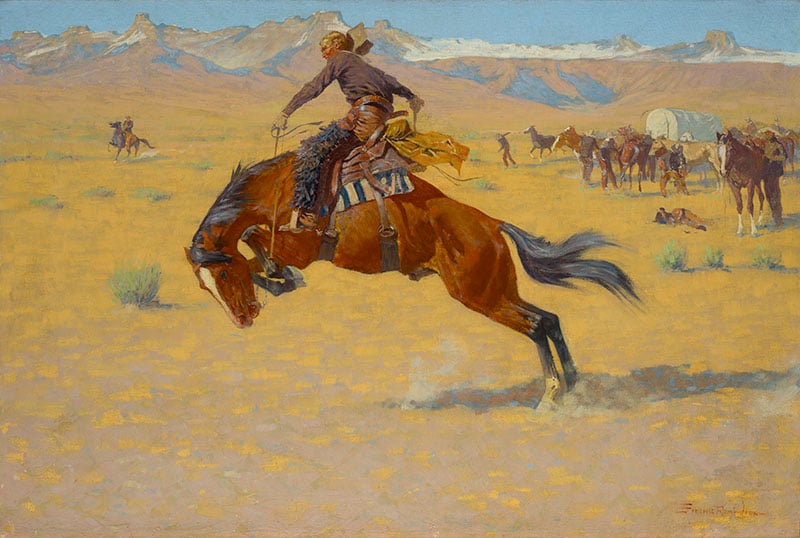People as Subjects: Creating the Characters of the West
Frederic Remington, A Cold Morning on the Range, c. 1904.
Background Information
When we think of typically “American” characters, we often think of individuals tied to the American West—pioneers and cowboys, for example. While their characteristics certainly developed from their life here, their images, as we have come to know them, were created by the artists that immortalized them. Western American artists observed the rugged individuals in their settings, and elaborated upon their appearances to create effect, tell a story, or evoke particular emotions. Eventually, it became difficult to distinguish the trappings of the exaggerated characters from the actual lives of these individuals.
Look Closer

Focus on the main character in the painting. The character’s pose,
facial expression,
clothing,
surroundings,
Notice the other individuals in the painting, and contemplate their relationship with the main character.
Frederic Remington, A Cold Morning on the Range, c. 1904.
Focus on the main character in the painting. The character’s pose1, facial expression2, clothing3, surroundings4, and accessories5 have been added by the artist to tell us what we should know about this person and situation. Notice the other individuals in the painting, and contemplate their relationship with the main character6.
Discussion Questions
- Who is the main character in the painting? How can you tell?
- How is the character posed?
- What expression is the character making on his face? What emotion does it depict?
- What is this character wearing, holding, and using?
- Where is this character located in the scene?
- What do you notice about how the other individuals are depicted in this painting?
- What does this tell you about the relationship between the artist and his subjects?
Activity
What makes a character? Artists tend to incorporate certain elements to give a viewer a sense of the character’s personality, including clothing, facial expression, pose, and accessories. Pair up with a partner from class. Ask your partner the questions on the interview worksheet to get to know more about them. After you answer the questions, draw a portrait of your partner, turning them into a recognizable character by incorporating the elements mentioned above. Consider what your character might wear, hold, use, what emotions are present, or their location in the scene.
Materials:
Interview worksheet
Paper
Pencils
Colored pencils/crayons/markers/watercolors
Grade levels: P-12 CO Standards
Visual Arts (2020)
Preschool: 1.1 ; 2.1 ; 3.1 ; 4.1
Kindergarten: 1.1 ; 2.1 ; 3.1 ; 4.1
1st Grade: 1.1 ; 2.1 ; 3.1 ; 4.1
2nd Grade: 1.1 ; 2.1 ; 3.1 ; 4.1
3rd Grade: 1.1 ; 2.1-2 ; 3.1 ; 4.1
4th Grade: 1.1-2 ; 2.1-2 ; 3.1-2 ; 4.1
5th Grade: 1.1-2 ; 2.1-2 ; 3.1-2 ; 4.1
6th Grade: 1.1-3 ; 2.1-2 ; 3.1-3 ; 4.1-3
7th Grade: 1.1-3 ; 2.1-2 ; 3.1-3 ; 4.1-3
8th Grade: 1.1-3 ; 2.1-2 ; 3.1-3 ; 4.1-3
High School: 1.1-3 ;2.1-3 ; 3.1-3 ; 4.1-3
Social Studies (2020)
Preschool: 1.1 ; 2.1 ; 4.1
Kindergarten: 1.1-2 ; 2.2 ; 3.1
1st Grade 1.1-2 ; 2.2 ; 3.1 ; 4.2
2nd Grade: 1.1-2 ; 2.2
3rd Grade: 1.1-2 ; 2.1-2 ; 4.1
4th Grade: 1.1-2 ; 2.2 ; 3.2
5th Grade: 1.1-2 ; 2.1-2
6th Grade: 1.1-2 ; 2.2
7th Grade: 1.1
8th Grade: 1.1-2 ; 2.1-2
High School: 1.1-3 ; 2.1-3 ; 3.1-2 ; 4.1
Reading, Writing and Communicating (2020)
Preschool: 1.1-2 ; 2.1-3 ; 3.1 ; 4.1
Kindergarten: 1.1-2 ; 2.3 ; 3.1-4 ; 4.1
1st Grade: 1.1-2 ; 2.3 ; 3.1,4 ; 4.1
2nd Grade: 1.1-2 ; 2.3 ; 3.4 ; 4.1
3rd Grade: 1.1-2 ; 2.3 ; 3.4 ; 4.1
4th Grade: 1.1-2 ; 2.3 ; 3.4
5th Grade: 1.1-2 ; 2.3 ; 3.4
6th Grade: 1.1-2 ; 2.3 ; 3.4
7th Grade: 1.1-2 ; 3.4
8th Grade: 1.1-2 ; 3.4
9th/10th Grade: 1.1-2 ; 2.3 ; 3.4
11th/12th Grade: 1.1-2 ; 2.3 ; 3.4
Resources



